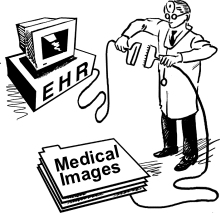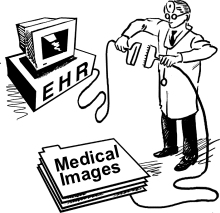EHR PACS integration matters

A Picture is Worth a Thousand Words
Since the accelerated acceptance of electronic health records (EHR), brought on by the adoption of the Affordable Care Act, patient records have existed separate and apart from their related medical images. There is no doubt that physicians unanimously believe that an integrated view of your medical image together with the textual description of your symptoms, test results and diagnosis would be more valuable than either of them separately. So, why do they remain detached? Why does EHR PACS integration matter?
Part of this is due to the technology challenges of storing and visualizing graphical pixels vs. character text. Storing text takes much less storage than imaging. Storing and viewing images, especially high resolution, multi-dimensional scans, represents a completely different challenge. Technology has come a long way in the past decade. Scroll down any web-page and you will see video/image advertisements above, below, next-to and in front of the article you’re reading. Patient EHRs and imaging PACS together don’t have to be more complicated than that.
 Most of the blame for this segregation rests on the very same legislation that created the EHR landslide. Meaningful use provides little incentive for providers to tackle this problem.
Most of the blame for this segregation rests on the very same legislation that created the EHR landslide. Meaningful use provides little incentive for providers to tackle this problem.
As Bob Dylan proclaimed, “the times they are a changin’...”
Despite the lack of financial incentive, proper patient care demands that medical images and patient records be viewed as one complete patient record. Almost every EHR system already includes a skeleton key than can unlock the doors that have shut images out of their systems. With this key in hand, medical image vendors, like Purview, can very efficiently enable the connection and integration of the two with a single sign-on. No need remembering, resetting or retyping another username and password into another log-in requiring additional complications and more key strokes.
Unfortunately, there are still EHR vendors who are unable or unwilling to open these gates. We have had several EHR vendors (who’ll remain nameless), who imposed a fee on their clients despite the fact that the vendor would not have to expend any effort at all to enable this functionality. (If you are interested in an EHR PACS integration, be sure to ask your vendor these 3 questions we wrote about in a recent blog.)
The time has come for providers to demand these keys from their EHR vendors and to engage PACS vendors who are capable of enabling this long overdue marriage.
Want to connect your patient medical records and images?
Click below to learn more and get started


